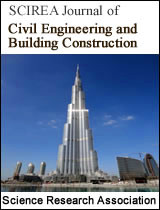Effect of Electrical Resistivity of Mortar Surface Layer on Drilling Speed Using Mix Proportion
DOI: 10.54647/cebc560117 89 Downloads 109215 Views
Author(s)
Abstract
In this study, we conducted electrical resistivity tests and small-diameter drilling tests on mortar surface layers using water-cement ratio and unit water content as experimental factors, and we investigated the effect of electrical resistivity on the drilling speed. Results showed that water content had a considerable effect on electrical resistivity depending on the water-cement ratio. Further, an increase in water-cement ratios tended to increase the drilling speed, which indicated a highly positive correlation. Moreover, the quality of the mortar surface layer could be estimated by the drilling speed even when the difference in the water-cement ratios was approximately 5%. However, the effect of the unit water content was small and did not have any specific relationship with electric resistivity, water content, or drilling speed.
Keywords
mix proportion, mortar, electric resistivity, water content, small-diameter drilling test, drilling speed
Cite this paper
Sato Sho, Asuka Yamashita, Ayumu Yasue, Shigeru Fujimori, Toshitsugu Inukai,
Effect of Electrical Resistivity of Mortar Surface Layer on Drilling Speed Using Mix Proportion
, SCIREA Journal of Civil Engineering and Building Construction .
Volume 8, Issue 1, February 2023 | PP. 34-48.
10.54647/cebc560117
References
| [ 1 ] | Nakarai, K, Kurashige, I, and Kishi, T (2013) Post-construction quality verification of in-place reinforced concrete. Concrete. Journal 51-2: 153-158 |
| [ 2 ] | Hasegawa, T, Hatanaka, S, Mishima, N, and Tanigawa, Y (2006) Strength evaluation of hardened cement using a drilling surface layer strength testing device. Proceedings of the Japan Concrete Institute 28-1: 1877-1882 |
| [ 3 ] | Park, S, Fujimori, S, Aoki, T, and Hatanaka, S (2017) Estimation of concrete compression strength using a small-diameter drill testing device. Proceedings of the Japan Concrete Institute 39-2: 1207-1212 |
| [ 4 ] | Yasue, A, Kato, K, Fujimori, S, and Inukai, T (2019) Effect of mix proportion factors on the air permeability and drilling speed of hardened mortar surface layers. Proceedings of the Japan Concrete Institute 41-1: 527-532 |
| [ 5 ] | JSCE Concrete Committee/Criteria-Related Committee (2018) Establishment of JSCE Criteria "Electrical resistivity testing method of concrete using the four-electrode method (proposed) (JSCE-K 581-2018)". Journal of JSCE E74-4: 260-274 |
| [ 6 ] | Kashima, T, Kawano, H, Watanabe, H, and Tanaka, Y (1999) Fundamental study on electrical resistance for assessing durability of concrete. Proceedings of the Japan Concrete Institute 21-2: 895-900 |

